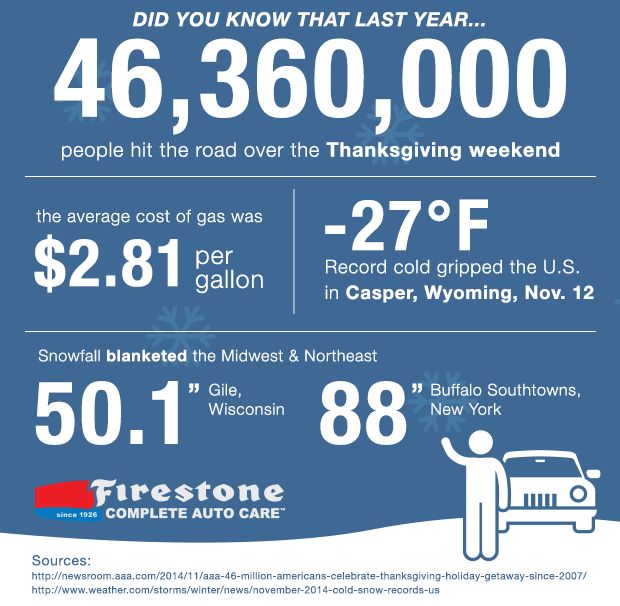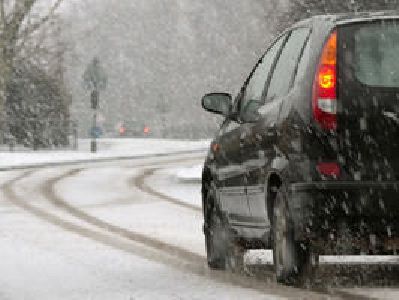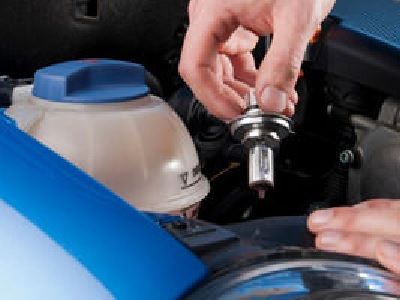Things to Know Before You Hit the Road
With holiday travel right around the corner, we know that you’ll be hitting the road more frequently and for longer distances. Knowing that, we want you to have all the tools to stay safe.
Make sure your tires are properly inflated.
Letting air out of tires to drive in snow can reduce the gripping action of tires because the tread will not meet the road surface as it was designed to do. Over-inflation has the same effect.
Keep your gas tank at least half-full.
The extra volume can help reduce moisture problems within your fuel system. It also adds a margin of safety should you become stopped or stranded during your trip.
Check windshield wiper blades to make sure they work properly.
There is nothing worse than getting a few miles into a rainy trip and realizing you can’t see well.
Give your car a once over.
By checking all fluids, hoses, and lights before leaving you can hit the road with peace of mind.
Consider keeping these items in your vehicle:
Snow Driving Tips
And if you are one of the lucky (or unlucky, depending on how you look at it) people that will be driving in cold temperatures, sleet and snow here’s what you need to know!
Use dedicated snow and ice tires if you live in areas where snow and ice are certainties of winter driving.
Snow and ice tires have a softer tread compound and a unique tread design to provide enhanced traction and road-gripping capabilities. Install snow tires all the way around the vehicle, not just on the drive axle. More information on Blizzak snow tires.
Have your mechanic test the anti-freeze/coolant.
This will provide the correct level of protection required in your driving area. Schedule an appointment now.
Try to remove ice and snow from your shoes before getting in your vehicle.
As snow and ice melt they can create moisture build-up, causing windows to fog on the inside of the vehicle.
Scrape the ice and snow from every window of the vehicle.
And scrape exterior rear view mirrors, not just a small patch on the windshield. Don’t forget to clean the headlights and brake lights.
During winter months, know the weather where you are, where you’re going and everywhere in between.
If snow or ice is predicted, make plans to leave early or arrive later. An alarm clock set to an earlier time can be a good friend in helping you avoid difficulties.
4 wheel drives slip on the ice just as much as 2 wheel drives.
So slow down on ice, 4x4s!
Wash your car on moderately warm days in the early part of the day.
This will prevent windows and doors from icing up overnight. In the extreme cold avoid the car wash. Road salt doesn’t work in these temperatures, thus your car won’t rust.
There’s a different grade of windshield washer fluid to use in the winter.
It’s a bit more expensive, but will not freeze in temperatures below 32 degrees.
Starting your engine and letting it warm up prior to driving is a good idea.
Keep in mind that although your engine may be warm and ready to run, other parts/fluids of your car are still cold. For instance, take it easy on your steering pump—the steering fluid is still cold and will warm up only after use. Drive slowly for a few blocks after pulling out of the driveway to give your car a chance to loosen up (much like you need after waking up in the morning). This will significantly reduce wear and tear on your car in the long run.
Be careful when digging out of the snow.
Shoveling can be very tough on your body. A lot of heart attacks happen this way. Also, if you are all alone, take off a few layers before shoveling to prevent sweating—the last thing you need is hypothermia. Sweat is your enemy. Lift with the knees, not your back.
For more information about how to prepare and stay safe while on the road read our Winter Driving Tips.
- Not sure who to call if something happens while you’re out on the road? Don’t leave home without our roadside assistance number. We’ll be there rain or shine!
- You can also schedule an appointment, view offers, find tires and find roadside assistance info on our mobile site.




